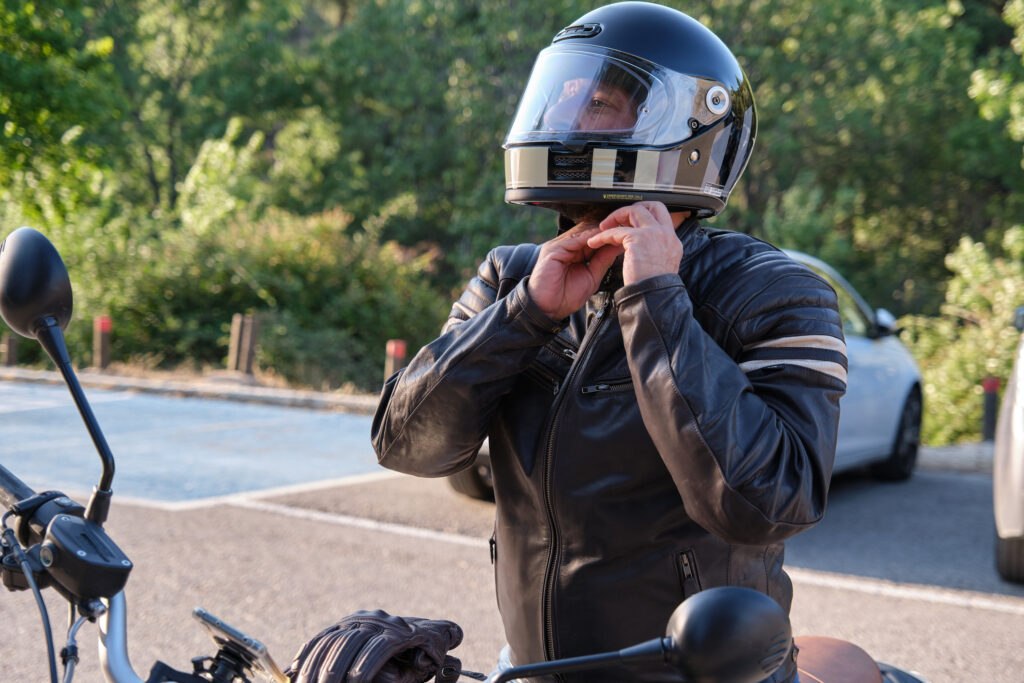California Helmet Laws
July 26, 2024 | Article by Chain | Cohn | Clark staff Social Share

At Cohn | Chain | Clark, we believe motorcycle riders should be able to ride Bakersfield’s roads without worrying about a careless or negligent driver causing an accident that leaves them seriously injured. When a rider is taking safety precautions, including wearing a helmet as required by law, and is hit by a car, the rider might have a claim for damages. Call our motorcycle accident lawyers at 661-616-9829 for help.
Protecting yourself as a motorcycle rider may include wearing some gear, such as a helmet, to lower the risk of severe head injuries. Especially now, when traffic accidents are at an all-time high, taking care of yourself is essential. Additionally, California has had rules requiring motorcyclists to wear helmets for decades.
Motorcycle Helmet Statistics
One study from 2008 found that motorcycle helmets lower your risk of getting a severe head injury by 69%. In 2015, NHTSA findings on helmet use and effectiveness showed that helmets are around 37% effective in preventing fatal motorcycle rider injuries. That same year, NHTSA also estimated that helmets saved approximately 1,772 motorcyclists nationwide and could’ve saved 740 more had the riders had helmets on.
Why Are Helmet Laws Necessary?
Many motorists enjoy piloting motorcycles because of the freedom it offers. You truly feel exposed to the elements–especially the wind. While this feeling can be exhilarating, there is not much protection in the event of a crash or accident. The added layer of defense that comes from wearing a helmet is essential to lessen the potential injuries from a motorcycle accident.
Although a helmet cannot protect you 100% of the time, your brain is one of the most important parts of your body. Anything you can do to try and prevent a severe injury to it will be worthwhile.
Here are some of the injuries that might occur after a motorcycle accident:
- Brain contusion – A bruise to the actual brain that could cause internal bleeding or swelling. These injuries are very painful and can cause lasting damage if not treated quickly and adequately.
- Intracranial hemorrhage or hematoma – Occurs when a blood pool collects in the skull. It can lead to pressure on the brain itself, resulting in additional problems.
- Skull fracture – A crack or break in the skull can lead to a multitude of issues in the brain, including a contusion or hematoma.
- Traumatic brain injury (TBI) – One of the hardest injuries to deal with, a TBI can range from a concussion to a permanently-disabling condition. TBIs can significantly affect an individual’s behavior or personality, and few existing treatments exist.
Those who sustain a head injury should immediately seek medical evaluation. To avoid consequences that may last for the rest of your life, you should try to begin treatment as soon as possible. Physical and cognitive impairments may make it difficult to enjoy your life the same way.
If you sustain an injury while wearing an approved safety helmet, you should contact a California motorcycle accident lawyer for legal assistance.
California Motorcycle Helmet Law
California has a universal helmet law, which means it applies to all bikers. Division 12, Chapter 5, Article 7, Section 27803 of the California Vehicle Code states that all drivers AND passengers on motorcycles, motor-driven cycles, or motorized bicycles must wear a safety helmet.
What Defines a Safety Helmet?
Not just any helmet will do the job in California. Motorcycles go faster than bikes and require more intense protection. The United States Department of Transportation (DOT) enforces safety standards for all motorcycle equipment retailers and manufacturers. Before being sold to riders, helmets are tested for the following features:
- Positional stability – How likely is the helmet to be in the correct place on the head during a critical moment?
- Strength of retention system – Will the fastening straps be durable enough to withstand a collision and hold the helmet in place?
- Impact – How effectively is the helmet defending the head against collisions with large objects?
- Extent of coverage – How much of the head does the helmet protect in the event of an accident?
Any helmet that meets DOT standards will have a certification sticker showing at least the minimum level of safety. The DOT standards are very low relative to other groups. If you are looking for a safer helmet, you may consider looking for a certification with more comprehensive criteria.
Snell Memorial Foundation is an independent, non-profit organization that has tested helmets for over 50 years. They set some of the strictest standards. If you see a Snell-Certified helmet, it will likely meet and exceed DOT requirements to offer increased protection and safety.
In addition to those qualities required by the law, here are some other factors you should consider when buying a safety helmet in California:
- Fit – The helmet should come to the area of your forehead just above your eyebrows for maximum protection.
- Helmet size – You don’t want a helmet that is too tight. It should fit around your whole head. If it is too big, add additional padding to make it snug, but it should not be so tight that it’s uncomfortable.
- Helmet straps – The straps should fit tightly around your ear and under your chin, so the helmet does not shift.
- Appropriate certifications – Whether you’re looking to meet minimum safety requirements with a DOT-approved helmet or shooting for maximum protection with a Snell helmet, you should ensure that the product you want has the certification you are looking for. This should be an easy sticker to see someone on the new product.
Snell recommends updating your helmet at least once every five years to keep your head as safe as possible.
Sometimes a helmet might be defective due to design or manufacturing issues. Suppose you are involved in a motorcycle accident in California and believe your helmet failed to do its job. In that case, you may be able to file a product liability claim against the retailer, distributor, or manufacturer. Talk to a Bakersfield motorcycle attorney for more information.
Punishments for Disobeying Helmet Safety Law in California
You may be subject to criminal and civil consequences if you do not follow California motorcycle helmet law.
In California, riding a motorcycle without a good safety helmet is illegal. Since having no helmet equates to an immediate safety hazard, the California Highway Patrol can punish you with a fine of up to $250 and/or put you on probation for a year.
From a civil (non-criminal) perspective, you may be liable for much more significant legal consequences. For example, you may not be able to recover full damages from a motorcycle accident case if you were not wearing a helmet. Due to pure comparative negligence laws in California, your compensation is reduced depending on how responsible you were for your injuries. Since wearing a helmet could have significantly lessened the damage or perhaps prevented it altogether, not properly wearing an acceptable helmet can cause you to take a percentage of the fault. Even if the other driver was distracted or made a serious mistake, they would only be responsible for covering a fraction of your injuries if you were not wearing a proper helmet.
California Motorcycle Helmet Law History
Over 50 years ago, in 1967, the federal government gave states no choice but to implement universal motorcycle helmet laws if they wanted money for highway safety funds. After Congress revoked federal authority to punish states for noncompliance, some areas began rolling back their legislation.
California enacted its motorcycle helmet law in 1992. Although many states were switching to laws requiring only children and teens to wear head protection, California was one of the first to make its non-restrictive helmet law. The difference in motorcycle fatalities was substantial.
From 1991 to 1992, the number of motorcycle deaths decreased by an estimated 37.5%.
California Bike Helmet Law
Not to be confused with the motorcycle laws, California also has a separate helmet law that requires any children under the age of 18 to wear a helmet when riding bicycles, skateboards, non-motorized scooters, or roller skates in certain areas. Helmet laws may not apply on private property, but they must be followed on public streets, trails, and bike paths. Violations of this law will result in a maximum fine of $25. The parent or guardian will be held responsible for paying the fine in case of a traffic citation.
California does not require adults 18 years or older to wear a helmet while riding or operating one of the modes mentioned above of transportation. Still, it will decrease the risk of a head injury, which may be why some state municipalities have implemented helmet laws for cyclists of all ages. Even non-residents passing through places like Bidwell Park, El Cerrito, or the city of Chico may be subject to a $25 fine if they do not wear a helmet.
Money collected from helmet law fines typically goes to the county health department for educational safety programs that encourage the use of helmets and even assist low-income families in obtaining them.
Contact Chain | Cohn | Clark for Help After a Motorcycle Injury
Our Bakersfield injury law firm covers a wide range of practice areas, including motorcycle and bicycle accidents. While bicycle accident faults may be more complicated as there are different laws in different areas, motorcycle laws are relatively uniform throughout the State.
Our experienced attorneys understand these laws and can help you recover compensation if you are injured in a motorcycle accident caused by another negligent driver. You will have a strong case for monetary benefits to treat any injuries you sustained, especially if you were wearing your helmet and it was fastened correctly.
We want you to be safe. Follow California helmet laws to prevent a dangerous accident. If you’ve already been in a motorcycle accident, contact our law firm as soon as possible to begin your journey to compensation.

